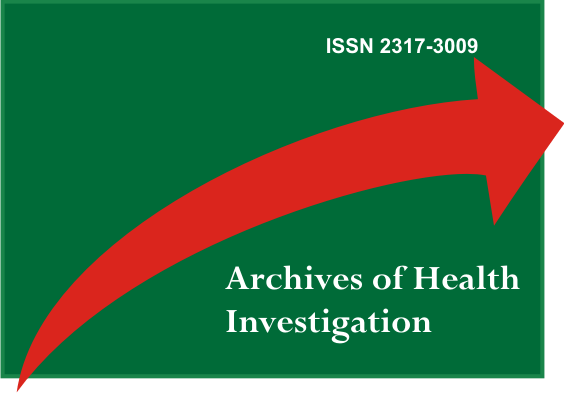Pseudoanquilose da articulação temporomandibular devido ferimento de arma de fogo: abordagem cirúrgica de dois casos
DOI:
https://doi.org/10.21270/archi.v7i1.2281Resumo
A pseudoquililose da articulação temporomandibular (ATM) é uma condição rara muito menos frequente que as anquiloses intracapsulares (verdadeiras). A infecção, o trauma e a artrite são algumas das causas das limitações progressivas para a abertura da boca. O tratamento mais comum consiste em coronoidectomia unilateral ou bilateral. Este artigo tem como objetivo relatar dois casos clínicos de pacientes com pseudoanquilose da ATM devido a uma lesão causada pelo ferimento de arma de fogo, submetidos a coronoidectomia unilateral e remoção de projéteis de arma de fogo sob anestesia geral e acesso intraoral.Descritores: Articulação Temporomandibular: Anquilose; Cirurgia Bucal.
Downloads
Referências
Rikalainen R, Lamberg MA, Tasanen A. Extra-articular fibrous ankylosis of the mandible after zygomatic fracture. J Maxillofac Surg. 1981; 9(2):132-6.
Hollins RR, Moyer DJ, Tu HK. Pseudoankylosis of the mandible after temporal bone attached craniotomy. Neurosurgery. 1988;22(1 Pt 1):137-9.
Kumar P, Singh V, Agrawal A, Bhagol A, Bali R. Incrementsl increase in percentage mouth opening after coronoidectomy in temporomandibular joint ankylosis. Int J Oral Maxillofac Surg. 2015; 44(7):859-63.
Al-Saadi, Al Hashmi A. Outcomes of coronoidectomy as treatment of coronoid pseudoankylosis and hyperplasia: case series. Oral Maxilofac Surg. 2017; 46(Suppl 1):224.
Gaetti-Jardim EC, Oliveira JG, Mendonca JC. Bilateral temporomandibular joint ankylosis as sequel of bilateral fracture of the mandibular condyle and symphysis. Oral Maxilofac Surg. 2014; 18(1):39-42.
da Costa Araujo FA, Melo Barbalho JC, de Farias ON, Jr., de Vasconcellos RJ, do Egito Vasconcelos BC. Pseudo-ankylosis caused by osteoma of the coronoid process. Ann Maxillofac Surg. 2014; 4(2):208-10.
Baraldi CE, Martins GL, Puricelli E. Pseudoankylosis of the temporomandibular joint caused by zygomatic malformation. Int J Oral Maxillofac Surg. 2010;39(7):729-32.
Rikanailen R, Lamberg MA, Tasanen A. Extra-articular fibrous ankylosis of the mandible after zygomatic fracture. J Maxillofac Surg. 1981;9(2):132-6.
de Santana Santos T, Frota R, Martins-Filho PR, Vajgel A, de Albuquerque Maranhão-Filho AW, de Oliveira e Silva ED. Fracture of the coronoid process, sphenoid bone, zygoma, and zygomatic arch after a firearm injury. J Craniofac Surg. 2011;22(6):e34-7
Johnson J, Markiewicz MR, Bell RB, Potter BE, Dierks EJ. Gun orientation in self-inflicted craniomaxillofacial gunshot wounds: risk factors associated with fatality. Int J Oral Maxillofac Surg. 2012;41(8): 895-901.
Powers DB, Delo RI. Characteristics of ballistic and blast injuries. Atlas Oral Maxillofac Surg Clin North Am. 2013;21(1):15-24.
de Oliveira DM, Vasconcellos RJ, Laureano Filho JR, Cypriano RV. Fracture of the coronoid and pterygoid processes by firearms: case report. Braz Dent J. 2007;18:168-70.
Shen L, Li J, Li P, Long J, Tian W, Tang W. Mandibular coronoid fractures: Treatment options. Int J Oral Maxillofac Surg. 2013; 42(6):721-6.
Spijkervet FKL, de Bont LGM, Boering G. Management of pseudoankylosis of the temporomandibular joint: Report of cases. J Oral Maxillofac Surg. 1994; 52(11):1211-7.
Lehman H, Fleissig Y, Abid-el-raziq D, Nitzan DW. Limited mouth opening of unknown cause cured by diagnostic coronoidectomy: a new clinical entity? Br J Oral Maxillofac Surg. 2015; 53(3):230-4.


